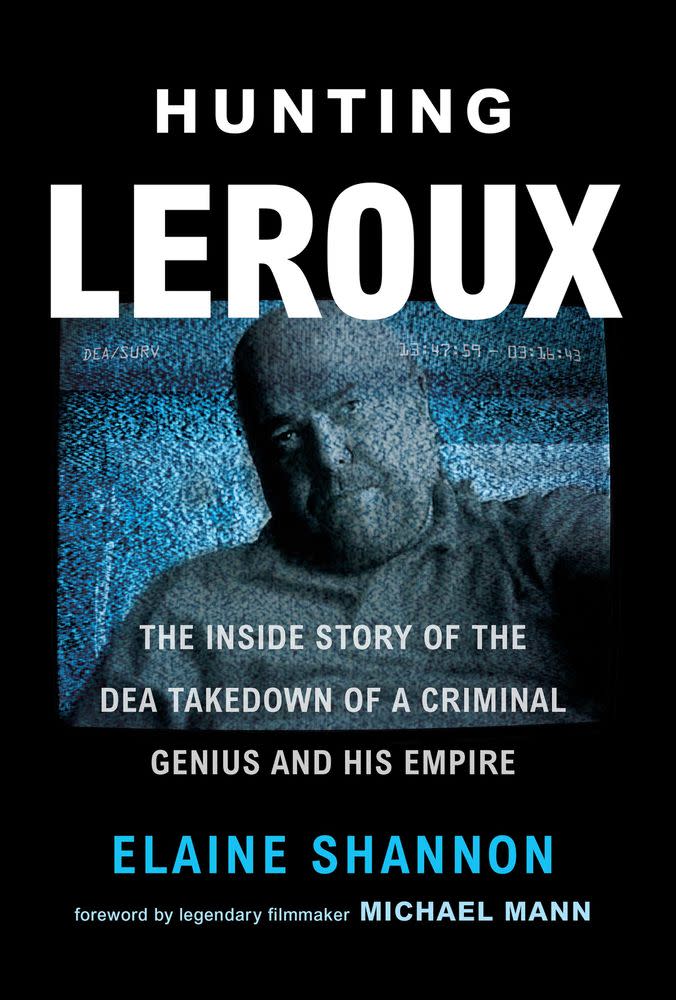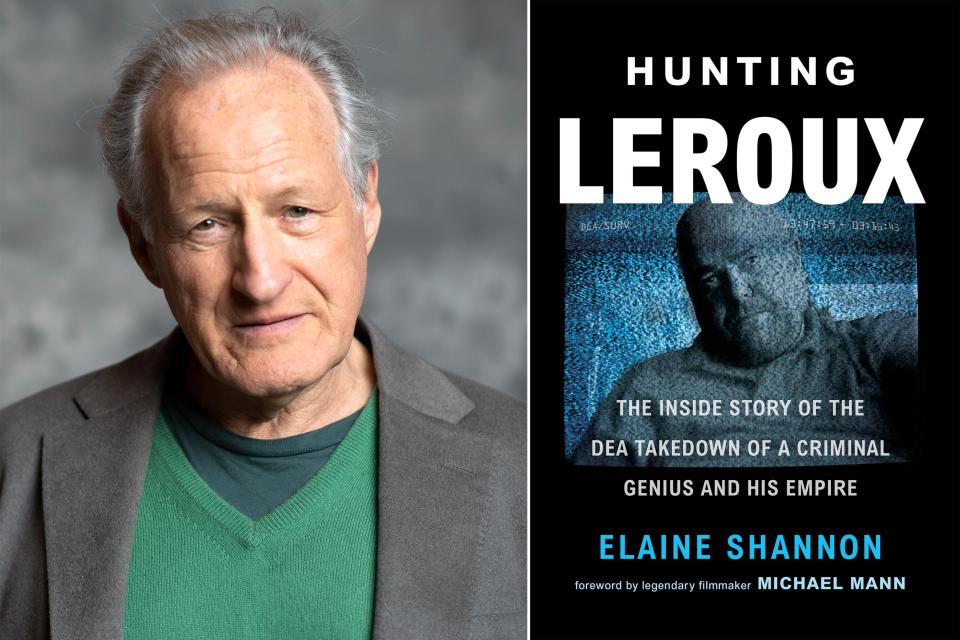Read Michael Mann's pulse-pounding intro for the true-crime book Hunting LeRoux
Journalist Elaine Shannon’s harrowing new true-crime book Hunting LeRoux hits stores Wednesday, and Entertainment Weekly has the intro penned by the book’s editor and publisher — Heat and The Insider filmmaker Michael Mann.
As Shannon told EW, Mann helped her make the narrative “sharper, clearer, and more accessible” as he oversaw the book as the first title in his new Mann Books publishing imprint.
It’s the story of Paul LeRoux, a former encryption programmer turned transnational drug and weapons kingpin, and the international effort to not just capture and prosecute him but also unravel the decentralized crime syndicate he helped empower around the globe.
Here’s Mann’s perspective on the chilling, larger-than-life story:

We’re sitting in a Gulfstream II, staring at a steroid-popped musclebound ex–NATO sniper in handcuffs. He looks out the window. We lift off from Monrovia, Liberia. That look of ennui on his face decays into selfpity, because he knows he’s bound for longterm incarceration in the United States. He hasn’t uttered a word about the irony. He and his part ner, Tim Vamvakias, a former U.S. Army military policeman, ew from Phuket, Thailand, to murder a Libyan sea captain and drug transporter turned informant and the DEA agent for whom he worked. The “Libyan informant” has just arrested him. The targets were a setup. So were the coordinators who supplied staged surveillance photos of the targets, a daily log of their movements, the opportune kill spot, and the French mercenary in charge of their West African transportation and the sup plier of silenced .22 caliber pistols and Heckler & Koch MP7s.
On that Gulfstream, the man opposite Dennis Gögel, the hired killer, is “Taj.” Taj is a superstar undercover DEA agent, working with the agency’s elite and secretive 960 Group. Taj and the group’s boss, Lou Milione, staged themselves as targets. Another pair of mercenaries just as dangerous as Gögel and Vamvakias have been arrested simulta neously in Tallinn, Estonia. Yet another team of killers, including their leader, Joseph “Rambo” Hunter — a retired US Army sniper trainer — is being apprehended at this very moment in Phuket. We have been dropped inside a complex operation in which ve separate undercover stings, involving three different nations’ police forces in different parts of the world, all needed to be synchronized to conclude with arrests — simultaneously. That was so that none of LeRoux’s teams could alert any of the others.
Elaine Shannon’s Hunting LeRoux delivers us into close proximity to dangerous people in the most ungoverned places on the planet. The moment-to-moment, heartbeat-to-heartbeat suspense of the take-downs pervades many sections of Shannon’s book. Fiction would be hard pressed to match the tension and color and the new dimensions of criminality revealed here. There is nothing else quite like it. Its authenticity is based on her knowledge of federal and transnational law enforcement, criminal enterprises, and the trust of her sources, who are exclusive to her.
It, simply, is better than most crime stories people can make up. Shannon has the magical ability to write from inside the flow of actual events, making them come alive. You know it’s real, and you are there.
Reading Shannon’s partial manuscript almost two years ago, I felt I had never been taken inside an organized criminal empire within day-to-day proximity of its lethal and brilliant entrepreneur with such specificity. The atmosphere of danger and continual scrutiny is tangible. It’s as if we’re captive in a series called Lifestyles of the Rich and Malevolent.
Equally, the manuscript parachutes us into the lives of Tom Cindric and Eric Stouch, the two agents in the DEA’s secretive 960 Group, who initiated and are the protagonists driving the mainstream investigation into LeRoux. Across continents and time zones, in dark motel rooms and in dangerous countries, we are with law enforcement’s most major league big-game hunters.
The revelation at the center of this true-crime saga is Paul Calder Le Roux and the transformation he innovated. LeRoux is a cybertech genius turned crime lord — committing coldblooded murders along the way. He created a revolution in how transnational organized crime organized itself. LeRoux deconstructed the conventional ways even sophisticated drug cartels or arms merchants operated. They still had “farm-to-the-arm,” vertically integrated business models often locking them to physical locales. Infrastructure and personnel hierarchies made them vulnerable, visible, and out-o-fdate to LeRoux. He deconstructed that model and created something completely different. His criminal enterprises — linked by a dark web of his own invention — were like a cutting-edge Silicon Valley start-up, using the gig economy, pivoting quickly off failed ideas, capable of rapid scalability, and climbing a hockey-stick curve of success.
He — and those who have followed — traffic in advanced weapons systems, tonnages of drugs, and exotic fissile materials, and engage in money laundering. They corrupt struggling small countries into failed nation-states to provide transport hubs and service regional con icts. This new world’s innovator and its architect is Paul Calder LeRoux.
Early on, the 960 Group came to the realization that LeRoux was the Elon Musk, the Jeff Bezos of transnational organized crime. They believe LeRoux is the “new now” as well as the near future.
Many in LeRoux’s presence describe his lethal aura of brilliance, deviance, and sociopathy.
As a dramatist, it is this additional quality of Hunting LeRoux that appeals to me, perhaps even more compellingly than its revelations. That is, our proximity. We are there. We are brought there because people trust Elaine Shannon. She has a reputation among intelligence agencies and top echelon law enforcement as a highly respected journalist who courageously goes where the story is, never betrays confidences, and gets it right. Their confidence in her, their openness, and the acuity of her insight — plus her irony and charm — is why the book has its unique ambiance and closeup engagement.
The agents driving the investigation — Cindric and Stouch; their bosses, Lou Milione and Derek Maltz; the undercover DEA agent Taj — share their rstperson perspectives, diaries, memos, documents, personal feelings, intuitions, suspicions, fears, and, sometimes, triumphs with Shannon. Their perspectives are woven into the compelling fabric of this narrative.
So, too, is the perspective of “Jack,” the man LeRoux calls his “golden boy.” Through the eyes of Jack, we are taken into LeRoux’s strangely-empty, twin luxury Manila penthouses and read his body language and experience the brainstorm-a-minute outbursts of this blond three-hundred-fifty-pounder. We’re flattered by his seductive speech and feel the danger of his MRI-like stare. Threat is redolent in the heat and humidity.
Jack built the compound and the militia for LeRoux in Somalia, helped him move money, and buy sumptuous safe houses. Jack flipped to Agents Cindric and Stouch and became their undercover source, reporting on and surreptitiously recording LeRoux at enormous personal risk. Not only had LeRoux created squads of killers, he’d begun pulling the trigger himself.
Overseeing Agents Cindric and Stouch is ASAC Lou Milione, one of the founders of the 960 Group under Special Operations Division chief Derek Maltz. Milione and his right-hand man, Wim Brown, have taken down some of the world’s most insulated and sophisticated criminal figures, including the arms merchant Viktor “Merchant of Death” Bout, Monzer alKassar, and Haji Juma Khan, an Afghani heroin kingpin. The 960 Group, quietly, is law enforcement’s heavy-hitter.
In Hunting LeRoux, Shannon creates a work in which we walk in the shoes, live in the skins, and see through the eyes of these people. It is a revelatory true-crime saga.
Michael Mann is an acclaimed four-time Oscar-nominated director, writer, and producer. His credits include Thief, Manhunter, The Last of the Mohicans, Heat, The Insider, Ali, Collateral, Miami Vice, Public Enemies, and Blackhat. He produced Martin Scorsese’s The Aviator and Hancock, and the television series Miami Vice, Crime Story, Luck, and Witness — as well as the Emmy-winning miniseries Drug Wars: The Camarena Story, based on Elaine Shannon’s bestselling 1988 book, Desperados, about the murder of DEA agent Enrique Camarena in Mexico.


